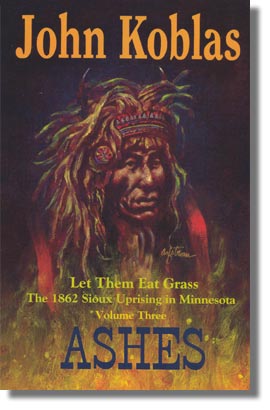Let Them Eat Grass
"The 1862 Sioux Uprising in Minnesota"
by John Koblas
Three Volume set chronicling the Dakota War of 1862 in Minnesota.

|
Let Them Eat Grass Volume I: Smoke Koblas details Indian history from the earliest times, carefully setting up the climate of inevitable confrontation with the arrival of white settlers in Minnesota. He explores the treaties made between the United States government and the Indian nations and explains why and how these treaties failed. Let Them Eat Grass, Volume 1: Smoke shows how both sides failed to understand the fundamental differences in culture, and how the pressure put upon the politicians in Washington D. C., to open lands for settlers enticed them to break treaties almost before the ink dried. The stage is well set for the coming conflict, including the skirmishes that preceded the uprising that had to come. |
|
Let Them Eat Grass Volume II: Fire On the morning of August 18, 1862, the roads leading down to the Lower Agency were full of armed Sioux warriors, hideous with paint and feathers, and eager to begin the carnage. Within minutes the startled inhabitants of the Lower Sioux Agency were aroused by a sudden barrage of gunfire. Although shocked, each and every person knew the meaning. The pauperizing effects of annuities, the political appointments of Indian agents, the establishment of reservations, and the slaughter of game on the Dakota hunting grounds, all contributed to the uprising that would terrorize Minnesota, Author John Koblas discusses the Dakota Conflict in Minnesota, through the early attacks on small settlements to the attacks on Fort Ridgely, New Ulm, and the battles of Birch Coulee and Wood Lake, culminating in the surrender of the Dakota at Camp Release. |

|

|
Let Them Eat Grass Volume III: Ashes Mr. Koblas takes his readers through the final stages of the 1862 Dakota conflict, culminating in the Battle of Wood Lake and the surrender of Little Crow's people at Camp Release. But the story does not end there and focuses on the trails of Dakota leaders, the mass hanging at Mankato, the death of Little Crow, the pursuit of the warriors into the Dakota and Montana Territories, and the war on a bigger scale: Fetterman, Custer, Wounded Knee, Sugar Point. Whether genocide or accident, if there is a villain in the story it is not peevish old Sitting Bull, or the yellow-haired boy general, but the American people and their never-ending list of places which the 'Indian did not need.' |
|
To Order: North Star Press Barnes And Noble Books John Koblas: jkoblas@gmail.com |
|
|